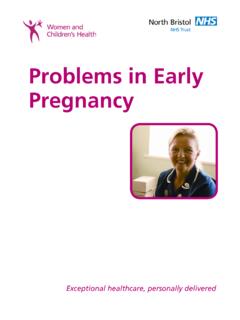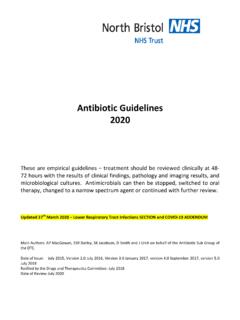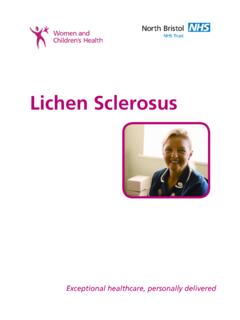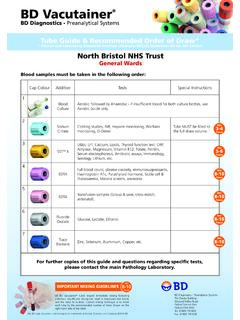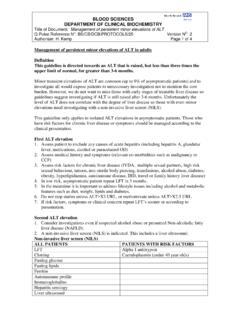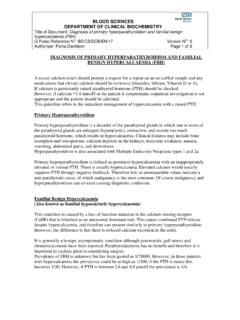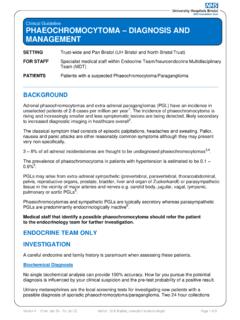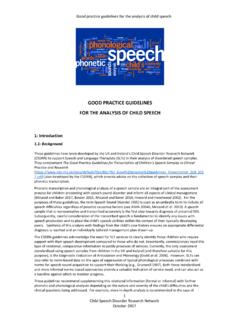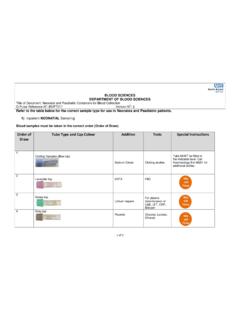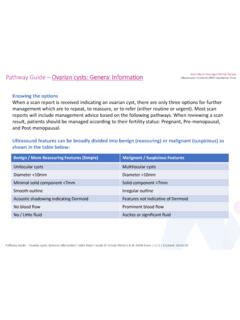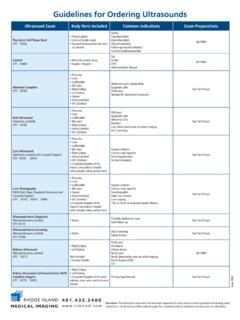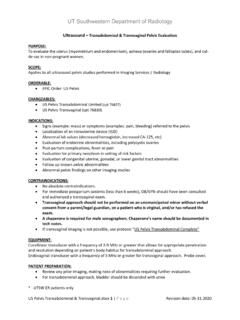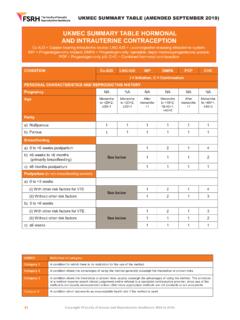Transcription of Guidelines for CA-125 Requesting - North Bristol NHS Trust
1 BLOOD SCIENCES DEPARTMENT OF BIOCHEMISTRY Title of Document: Guidelines for CA-125 Requesting Q Pulse Reference No: BS/CB/DCB/PROTOCOLS/36 Version NO: 9 Authoriser: Maryam Khan Page 1 of 7 Guidelines for CA-125 Requesting The purpose of this protocol is to provide guidance for the appropriate Requesting of the tumour marker CA-125 , referencing NICE Guidelines NG122 (Ovarian cancer: recognition and initial management). Definitions FP Alpha-fetoprotein HCG Beta-human chorionic gonadotropin CEA Carcinoembryonic antigen HE4 Human epididymis protein 4 HNPCC Hereditary Nonpolyposis Colorectal Cancer RMI Risk of Malignancy Index Background The best available marker for epithelial ovarian cancer is still considered to be CA-125 due to a combination of reliability and general availability. HE4 is more sensitive than specific than CA-125 , however the former is not in routine use. NICE still therefore recommends CA-125 rather than HE4.
2 CA-125 is used for the diagnosis of epithelial ovarian cancer. FP and HCG are useful for identifying those who have tumours of germ cell origin. Evidence base for using CA-125 in detection of ovarian cancer For use in diagnosis of epithelial ovarian cancer, the most frequently quoted reference range for CA-125 is 0-35 U/L. The care pathway for patients is shown in Appendix 2. The justification given in CG122 for this triage pathway ( measurement of CA-125 before referral for ultrasound) is as follows. Assuming a prevalence of ovarian cancer in women with symptoms presenting to primary care of : If all women with symptoms were referred to secondary care, around 1 in every 500 women referred would turn out to have ovarian cancer. The positive predictive values of the individual tests mean that around 1 in every 100 women referred to secondary care with positive serum CA-125 or ultrasound would have ovarian cancer.
3 Negative predictive values mean that 1 in every 2,000 women with negative tests would turn out to have ovarian cancer. Combining tests to improve sensitivity meant a reduced positive predictive value of to but an improved negative predictive value of to (depending on which combination was used). When using combined tests, if women were only referred if they had a positive serum CA-125 test or ultrasound scan, then 1 in every 157 referred would have ovarian cancer (assuming conditional independence between serum CA-125 and ultrasound). 3% of women with ovarian cancer and symptoms would not be referred. If women were only referred when both CA-125 test and ultrasound were positive, then 1 in every 26 referred would have ovarian cancer. 34% of women with ovarian cancer and symptoms would not be referred at initial presentation. Clinical specificity of CA-125 CA-125 is elevated in multiple benign diseases, some of which are shown in the table below (on page 2).
4 Other conditions associated with raised CA-125 levels are pregnancy, menstruation, ascites, heart failure and pleural effusion. CA-125 may also be raised in endometrial and cervical cancer. BLOOD SCIENCES DEPARTMENT OF BIOCHEMISTRY Title of Document: Guidelines for CA-125 Requesting Q Pulse Reference No: BS/CB/DCB/PROTOCOLS/36 Version NO: 9 Authoriser: Maryam Khan Page 2 of 7 Disorder Approx. % with CA-125 >35 U/L Endometriosis 24 Benign ovarian tumours 10 Acute salpingitis 40 Chronic salpingitis 8 Uterine myoma 10 Cirrhosis 67 Cirrhosis with ascites 100 Chronic active hepatitis 10 Acute pancreatitis 32 Chronic pancreatitis 2 Renal failure 15 Screening for ovarian carcinoma Problems with CA-125 as a screening test for ovarian cancer: lack of sensitivity for early stage disease (50% stage 1) lack of specificity Screening is a symptomatic decision. Symptoms are non-specific and widely experienced by the general population, but they have greater significance in women over 50 years old, or women with a significant family history (2 or more cases of ovarian or breast cancer diagnosed at an early age in first degree relatives.)
5 CA-125 cannot be recommended for general population screening to detect sporadic forms of the disease. Targeting a high risk population CA-125 may have a role in combination with transvaginal ultrasound and pelvic examination in the early detection of ovarian cancer in women with a hereditary ovarian cancer syndrome. Although there is no data showing that screening these high-risk women can reduce their mortality from ovarian cancer a NIH consensus statement has recommended that these women undergo at least annual testing. Diagnosis Serum CA-125 measurement and an abdominal and pelvic ultrasound, along with the woman s menopausal status, are used to calculate a risk of malignancy index. An RMI 250 necessitates referral to a specialist multidisciplinary team. Appendix 3 provides the definition of RMI. Confirmation of diagnosis is by histology or cytology. Prognosis CA-125 levels after chemotherapy is one of the strongest available indicators of disease outcome.
6 A prolonged half-life for CA-125 or a less than 7-fold decrease during the early months of treatment has also been shown to predict poor outcome. Monitoring The most important application of CA-125 is the monitoring of patients with epithelial ovarian cancer. Serial levels can pre-clinically detect recurrent disease earlier and more cost-effectively than radiological procedures. This may lead to altered patient management, but no study has yet shown this leads to enhanced survival. Women with a family history of ovarian cancer For women who either are HNPCC positive or have two or more 1st or 2nd degree relatives with ovarian cancer or young age breast cancer, screening is offered at St Michael s. If queries are received suggest that the doctor contacts Mr John Murdoch (Consultant Oncologist/ Gynaecologist) at St Michael s Hospital. BLOOD SCIENCES DEPARTMENT OF BIOCHEMISTRY Title of Document: Guidelines for CA-125 Requesting Q Pulse Reference No: BS/CB/DCB/PROTOCOLS/36 Version NO: 9 Authoriser: Maryam Khan Page 3 of 7 Main CG122 recommendations CA-125 should be measured in the following situations: Primary Care Women (especially if 50 or over) presenting with one or more of the following symptoms on a persistent (at least 1 month) or frequent (12 times per month) basis.
7 Persistent abdominal distension (women often refer to this as bloating ) feeling full (early satiety) and/or loss of appetite pelvic or abdominal pain increased urinary urgency and/or frequency unexplained weight loss unexplained fatigue unexplained changes in bowel habit (for example, constipation or diarrhoea) symptoms that suggest irritable bowel syndrome - if the woman is 50 years or over If serum CA-125 is 35 U/ml or greater, an ultrasound scan of the abdomen and pelvis should be arranged. Note: Patients should be referred to a gynaecological cancer service within 2 weeks if physical examination identifies ascites and/or a pelvic or abdominal mass (which is not obviously uterine fibroids). CA-125 measurement is not a prerequisite for referral; therefore referral should not be delayed whilst waiting for CA-125 result. If the woman has a normal serum CA-125 , or a raised CA-125 but a normal ultrasound, then the GP should assess her carefully for other clinical causes of her symptoms and investigate if appropriate.
8 Secondary care Measure serum CA-125 in all women with suspected ovarian cancer, if this has not already been done in primary care. In women under 40 with suspected ovarian cancer, measure FP and hCG as well as serum CA-125 , to identify women who may not have epithelial ovarian cancer. Reporting results All raised CA-125 results will come to clinical validation. Raised results on a first request should have the following coded comment where appropriate (mainly primary care samples): C125 Increased CA-125 , an ultrasound scan should be arranged, as per NICE Guidelines CG122. CA-125 is not specific for ovarian cancer and is raised in other malignancies and benign conditions including; menstruation, pregnancy, endometriosis, benign ovarian cysts , inflammatory pelvic disease, liver cirrhosis and ascites. Related documents NICE support tools to help you put CG122 guidance into practice Care pathways for ovarian cancer in primary and secondary care (from NICE CG122) References 1.
9 The recognition and initial management of ovarian cancer. NICE Clinical Guidelines , CG122. 2011 2. Screening for ovarian cancer: a systematic review. Health technology assessment. (Note: CG122 doesn t deal with population screening.) BLOOD SCIENCES DEPARTMENT OF BIOCHEMISTRY Title of Document: Guidelines for CA-125 Requesting Q Pulse Reference No: BS/CB/DCB/PROTOCOLS/36 Version NO: 9 Authoriser: Maryam Khan Page 4 of 7 Appendix 1: Support tools to help you put this guidance into practice This NICE slide set might be helpful when discussing this guideline in a practice meeting; the baseline assessment tool can help to identify where you might need to change your clinical practice, and there is online learning available. You can also find a podcast about this guidance, on the NICE website, featuring Dr Craig Dobson, a GP and Senior Lecturer in Medical Education and General Practice at Hull/York Medical School and a member of the guideline development group for the Ovarian Cancer guideline.
10 This podcast focuses specifically the use of CA-125 tests and how to manage patients who have negative results. For full information about this guidance, and support from NICE for putting the guidance into practice, see BLOOD SCIENCES DEPARTMENT OF BIOCHEMISTRY Title of Document: Guidelines for CA-125 Requesting Q Pulse Reference No: BS/CB/DCB/PROTOCOLS/36 Version NO: 9 Authoriser: Maryam Khan Page 5 of 7 Appendix 2: Care pathways for ovarian cancer in primary and secondary care (adapted from NICE CG122 interactive pathways) BLOOD SCIENCES DEPARTMENT OF BIOCHEMISTRY Title of Document: Guidelines for CA-125 Requesting Q Pulse Reference No: BS/CB/DCB/PROTOCOLS/36 Version NO: 7 Authoriser: Moya O Doherty Page 6 of 7 BLOOD SCIENCES DEPARTMENT OF BIOCHEMISTRY Title of Document: Guidelines for CA-125 Requesting Q Pulse Reference No: BS/CB/DCB/PROTOCOLS/36 Version NO: 7 Authoriser: Moya O Doherty Page 7 of 7 Appendix 3: Risk of Malignancy Index Calculation
